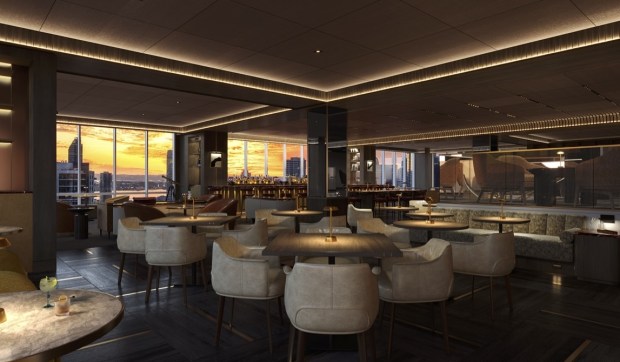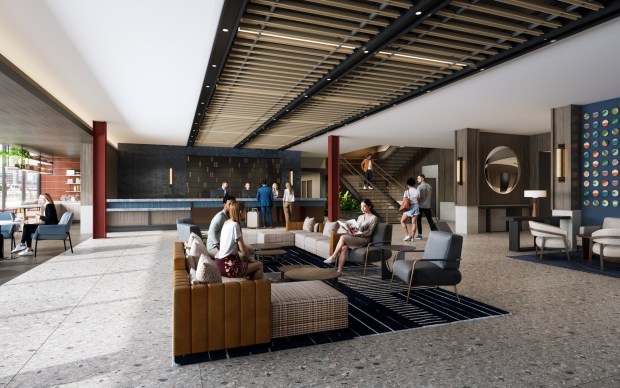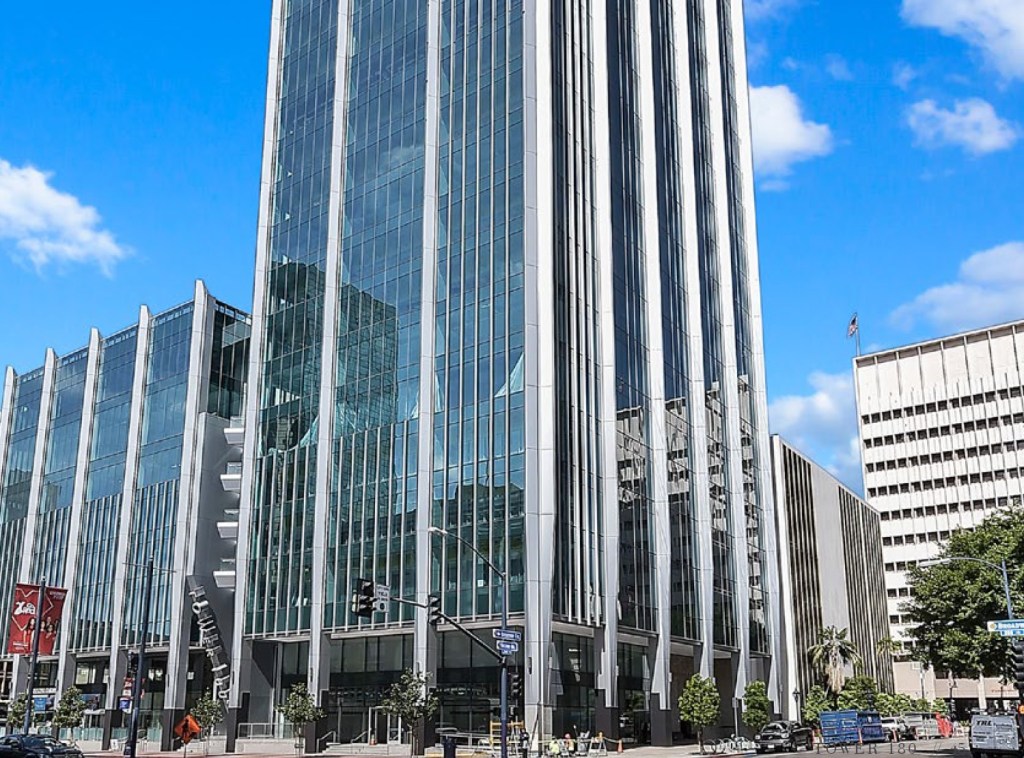A now vacant office high-rise in downtown San Diego will be transformed into a 560-room Hyatt hotel, marking what is believed to be the first such conversion in California in recent years.
The $250 million project, proposed by San Diego-based developer J Street Space, is a slight pivot from earlier plans to convert the 25-story Tower 180 building on Broadway into a combination of residential and hotel uses. The cost of that plan was originally estimated at $140 million.
While office-to-residential conversions are becoming more appealing to developers given the high office vacancy rates in many downtowns and the need for additional housing, J Street is bucking that trend.
Its now revised plan calls for a dual-branded hotel, composed of a 371-room Hyatt Place and a 189-room Hyatt House. While the rooms are different in size and function within the two brands — with the Hyatt House geared more toward extended-stay travelers — they will be intermingled within both the tower building and an adjacent eight-story annex.
 Rendering of rooftop cocktail lounge and bar at Tower 180. (J Street)
Rendering of rooftop cocktail lounge and bar at Tower 180. (J Street)
Topping off the high-rise will be an upscale rooftop bar and lounge that will be known as the Lurline Cocktail Club, which will showcase 360-degree views of San Diego’s skyline, bay and ocean.
J Street acquired the office complex in late 2023 for $61 million, according to property records, just a few years after the skyscraper got a major facelift. It’s partly that renovation, in concert with San Diego’s strong hospitality market, that gives J Street the confidence to proceed with a hotel conversion, its founder says.
“Tower 180 has unique advantages that make the economics work — the building’s infrastructure was already updated in 2020, it’s fully vacant, and it is part of a mixed-use development,” J Street CEO Saj Hansji said in an email to the Union-Tribune. “As we’ve continued to study the building and the market, we determined that a hotel concept would be the highest and best use for this property. This approach allows us to maximize the building’s unique attributes and better serve the strong demand we’re seeing in San Diego’s hospitality market.”
Hotel real estate broker Alan Reay of Atlas Hospitality said he knows of no other office building in California that has been converted into a hotel. That’s because developers and property owners have told him the financials don’t pencil out.
“A lot of the offices have internal spaces that don’t have windows, and then you have the cost of putting in individual bathrooms, and just the layout of the floor plans have not worked out,” Reay said. “Developers say it’s more economical to build from scratch or knock down the building rather than convert it. And they say they can sell those apartments for a lot higher than what they can get for hotel rooms.
“On top of that, we’re seeing so many projects being put on hold because the cost of construction has really increased.”
The project cost for Tower 180 has grown considerably from the original estimate, which Hansji attributes to the redevelopment’s expanded scope and density, as well as “premium amenities like the Lurline rooftop venue, that will make this an exceptional hospitality destination for downtown San Diego.”
As for financing, Hansji says J Street has solid relationships with its capital partners, who he does not name, adding that “the unique nature of this conversion, combined with the building’s existing infrastructure and our team’s track record, has positioned us well in the current financing environment.”
As uncommon as office-to-hotel conversions are in California, it’s not surprising to see J Street undertaking the Tower 180 project, says Joshua Ohl, director of market analytics at CoStar.
“Last year, over 1,900 market-rate apartments opened in downtown, pushing vacancy into double digits, while we’ve added few hotel rooms there in recent years,” he said. “Not having seen the interior layout, the full hospitality conversion likely just made more sense from a financial standpoint, even at that price.”
 Rendering of lobby in Tower 180 project. (J Street)
Rendering of lobby in Tower 180 project. (J Street)
The design for the dual-branded hotel calls for a lobby lounge and market on the ground floor, a breakfast bar with an additional overflow lounge on the second floor, and more than 12,000 square feet of meeting space across the ninth and tenth floors. There is no separate restaurant, nor a pool, although one was originally considered for the rooftop.
Current ground-floor retail tenants, among them Mendocino Farms, Blue Bottle Coffee and Anytime Fitness, will remain, the developer said.
San Diego-based architectural firm Delawie has had to work within certain design parameters dictated by Hyatt, but does have the freedom to imbue the design with a San Diego feel, said Delawie associate Logan Parmele.
“We’re pulling in colors and textures you’d experience in more urban areas, so there are some rust, reddish colors and light steel blues that you’d see as you travel around San Diego, like the red brick buildings in downtown, and soft sky blue colors,” Parmele said. “We’re also really opening up the ground floor lobby and exposing some of the structural steel there and on the second-floor lounge.”
The tower on 180 Broadway was originally built in 1963 as the U.S. National Bank Building, and the annex was added in 1973.
J Street, which originated as J Street Hospitality Inc. in 2011, has completed a number of hospitality projects in the downtown area, including The Courtyard Gaslamp, Hotel Z and the Residence Inn Gaslamp. It recently debuted the 39-room Bower Hotel, the first new lodging property in Coronado in more than three decades. The Bower took the place of the former Villa Capri motel and is located across the street from the Hotel del Coronado.
